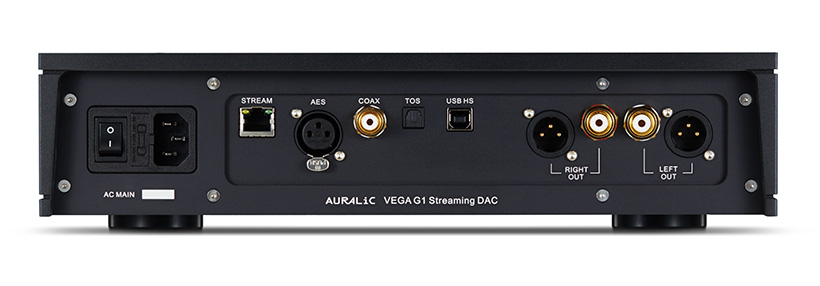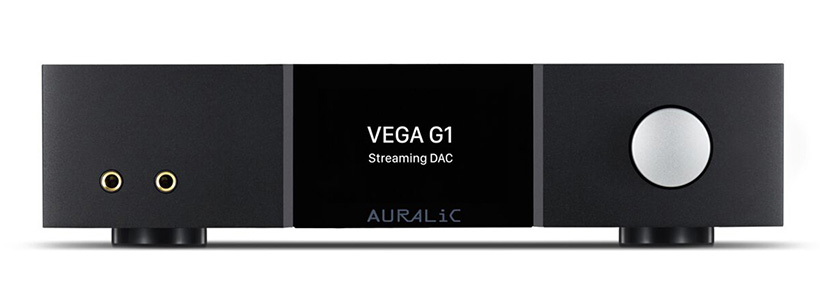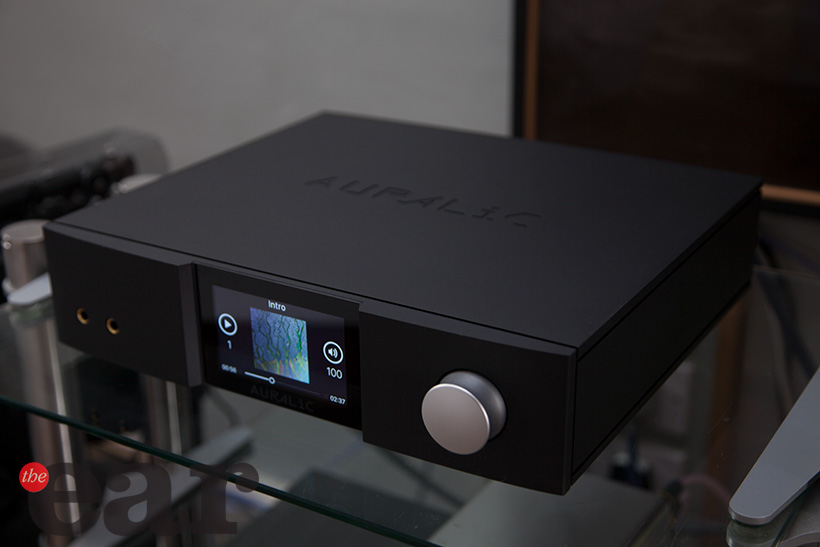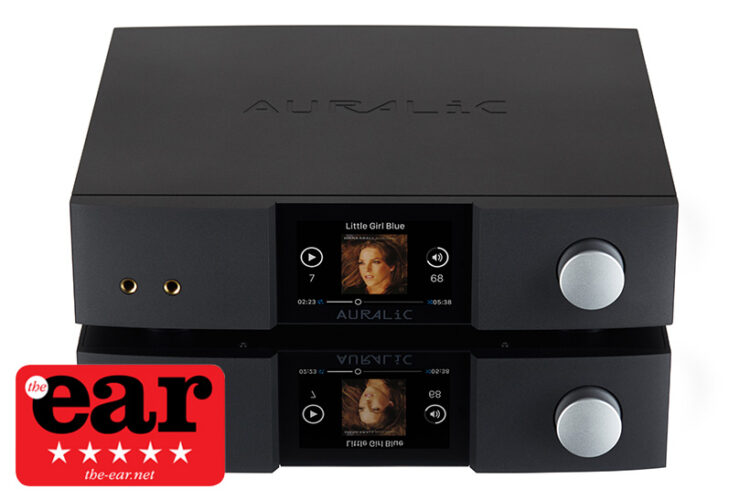When Auralic launched its G1 series they took the unusual step of using casework that looks almost exactly like that on the more expensive G2 range, at a glance you have to be reasonably familiar with the range to spot the difference. Which is in the knobs and buttons, G2s have black controls (that you can barely see in low light) G2 controls are silver. But the matte black aluminium casework is very similar in appearance. In practice the G2s have single piece, machined from billet boxes and G1s are bolted together, but the bolts are well hidden so there isn’t much to differentiate them.
The latest addition to the G1 range is the Vega which is a streamer and a DAC with volume controlled output, connect it to your power amp or active speakers and you’re away. It is significantly different under the skin to the Vega G2, the volume control is digital (on the DAC chip) not analogue and there’s no analogue input, galvanic isolation is not provided for all inputs and lightning link for hook up to a separate Auralic streamer or clock is also missing. It is therefore a more conventional product and some two thousand pounds or dollars more affordable as a result.

It shares a lot of the fundamental parts however, including the quad core processor and a feature set that provides access to streaming services including Qobuz, Tidal and Spotify Connect as well as the ability to access music stored on the local network. There is no form of wireless connectivity either to the network or for devices with Bluetooth or Airplay, a move that suggests sound quality is a key factor in its design. For best results you want to keep radio frequencies out of your audio equipment and Wi-Fi receptivity does not help in this regard. Like the Vega G2 it doesn’t run Auralic’s Lightning Server software, which while not a big deal for most is nuisance if you have an Innuos server because at present the only way to combine one with the other is via USB, the Lightning app won’t load an Innuos library which eliminates the ability to network stream between the two. That might not seem to be a problem but in my experience ethernet connections sound better than USB ones. There are of course other decent servers on the market.
Specs wise it’s up to speed with the ability decode DSD up to 512 and PCM up to 32-bit/356kHz, it’s Roon Ready and runs dual femto clocks for claimed jitter free operation. This must be aided by the fact that it combines a streamer and a DAC in one box avoiding the digital link required when these parts are separated. Construction and finish is of a standard commensurate with the price, in fact it’s better than many at this level, I particularly like the solidity of the casework and the brand carved into the top panel. Headphone users are catered for with two outputs, both on full size quarter inch jacks.

It’s worth mentioning the ace that all Auralic streamers keep up their matte black sleeves; the Lightning DS control app. This iOS only software is both very attractive and a nice to use, I have griped about its shortcomings in the past but these pretty much evaporated when I got an up to date iPad. The integration of both Tidal and Qobuz is likewise excellent, you don’t get the depth of background info that you do with Roon, but neither do you have to pay for it.
Sound quality
Streaming from a Melco N1ZS/2A server the Vega G1 is crisp and bold, it presents the music with a solidity and confidence that makes you want to listen for longer. Having used a Vega G2 in the last year but not having had the two units side by side it’s not possible to give a precise indication of the difference between the two but I suspect that the G2 is a smoother and more refined with better image depth and timing.

The G1 is a very capable machine however, one that digs into the detail of everything you play whether it be streamed or decoded via the USB input. Transparency to quieter sounds is very good because the tonal balance is unusually even, there has been no tuning for a specific sound as far as I can tell, rather the balance is clean and neutral. This means that what you hear more of what the artist and producer created and less of the hardware replaying it, which is the way it should be. The benefits of this approach can be heard in the imaging and clarity of Joni Mitchell’s Court and Spark which sounds very real thanks to the honest tonal balance and the Vega’s ability to convey melody as well as timing. With another female artist, Esperanza Spalding, the kick of ‘Earth to Heaven’ (Emily’s D+Evolution) is palpable and taut while the lyrics on ‘Ebony & Ivory’ are as clear as you like. The Vega G1reminded me of just how good that track is and highlighted the quality of drumming, something that is usually masked by the voice and overall rhythm of the piece. It’s not restrained when it comes to the beat but doesn’t push this element to the forefront in the way that some streamers are inclined, you could say that it’s a bit more even handed in this respect as well.
The rhythms on Bugge Wesseltoft and Prins Thomas’s eponymous album are as fat and juicy as you could wish for on the tracks that require it, while the more introspective pieces such as ‘Sin Tempo’ are presented in such calm and deliberate fashion that you can’t fail but gain insight into their creation. I really enjoyed the torquey build up of David Torne’s ‘Ak’ (as a good an example of guitar shredding as you are likely to find from his album Prezens) where he joins organ, bass drone, sax and drums that pierce the blackness of a silent background before the full intensity of the piece comes to a powerful climax. The contrast that this streamer pulls out of a classic ECM production is what gives it a lot of that power. It might not be as analogue smooth as its bigger brother but the Vega G1 has incredible dynamic capability when it’s called for.

The bass is a distinct strongpoint on this Auralic, strong and extended with precise attack and decay it contributes a lot to the three dimensional solidity that this G1 extracts from a range of recordings. It makes large orchestral pieces assured and expansive and this in turn delivers for very engaging listening. The treble is strong and clear, marking out the higher notes with energetic clarity. Haydn String Quartets are particularly exhilarating with a good source, on this occasion a USB feed from a Leema Sirius server. The latter is an Innuos Zen under the skin so very capable albeit not as good a match as the Melco via ethernet, but that could be a connection mode difference of course. One thing this pairing did very well was image depth, Doug MacLeod’s ‘Too Many Misses’ (Exactly Like This) made this very clear with the drums and bass sitting way back behind the voice and guitar in a very natural acoustic.
The Auralic Vega G1 is a well thought out streamer/DAC that clearly benefits from technology created for the considerably more spendy Vega G2. Naturally there are trade-offs but it does all the important things well, with neutrality of balance and consistency of timing being among the clearest. The combination of such engaging music making with very high build quality and one of the nicest control apps in the business make the Vega G1 a hard act to beat, put it with a decent server and it will deliver results that will revise your opinion of what can be done with digital audio.


